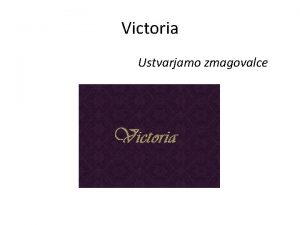World War I at Home Royal Victoria Hospital






- Slides: 6

World War I at Home Royal Victoria Hospital http: //www. bbc. co. uk/iplayer/episode/b 04 gkn 5 5/world-war-i-at-home-royal-victoria-hospital

Details: • Aired on: BBC Four • First shown: 7. 30 pm 2 Jun 2014 • Mode of Documentary: Expository • Form of Documentary: Historical Medical

Synopsis • Author Philip Hoare examines the shocking stories of the World War I Hampshire hospital doctors who faked footage on cures for shellshock. (Royal Victoria Hospital)

Analysis • Expository use of narration: Ø ‘Voice of God’ – shows authority, explains in detail what we are seeing on screen, such as with archive material. Ø On screen narrator – stereotypical use of white, middle aged, middle class man (this narrator can be seen as identifiable with audience and the use of this stereotype is traditional like war where men had to fight). Ø Narrator is a knowing voice – audience trust him and believe in his authority and therefore trust the unspoken contract on facts. Ironic as documentary is about footage that has been reenacted and is not factual. Ø Narrator Philip Hoare grew up close by – therefore as an audience we are more likely to believe what he tells us again ‘knowing voice’

Analysis • Expository use of script: Ø The exposition/line of argument provides a structure and anchors the documentary’s visual material such as the archive footage, showing re-enactments Ø Philip Hoare (narrator) is actually grew up close by to the hospital. His experience acts as script and gives the documentary its structure. • Expository use of Reconstructions: Ø The documentary does not use reconstructions as the documentary uses reconstructions of the past to tell its audience the ‘truth’ • Expository use of interviews: Ø Documentary features interviews with experts people who work in the building that was once the hospital. Interview still presents our on screen narrator Philip Hoare.

• Audience: Analysis Ø The primary audience of this documentary will be people interested in the world wars. The secondary audience will be people who enjoy watching documentaries. Ø I believe that this documentary targets people who fought in either world wars, as well as people who were growing up, or alive during either of the world wars. This is because they can relate to Philip Hoare’s experiences, as well as learn some ‘truth’ about the wars medial history. Ø In addition to this I believe it is mainly targeted at the older generation, as the programme was aired at 7. 30 pm, which is relatively early. And it can be stereotyped that the older gerneation are more likely to watch BBC documentaries than the younger generation, who are more likely to watch documentaries such as channel 4 documentaries (stereotypically)











